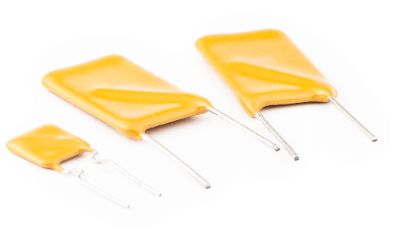What Is a Resettable Fuse?
 A resettable fuse is an electronic component that can be used repeatedly while serving as a fuse to prevent overcurrents.
A resettable fuse is an electronic component that can be used repeatedly while serving as a fuse to prevent overcurrents.
Also called a polyswitch or polyfuse. A PTC thermistor is made of conductive polymer and differs from a fuse in basic principle. A fuse interrupts a circuit by breaking the element due to heating when an overcurrent flows through it.
Resettable fuses, on the other hand, limit the current by increasing the temperature inside the element due to overcurrent, causing the resistance value to increase. Since many products are smaller than fuses, they can be used in smaller spaces, and their structures are resistant to breakage, shock, and vibration.
Uses of Resettable Fuses
Resettable fuses are used to protect circuits that are subject to repetitive overcurrents. They are also used for intentional short-circuits in high-density mounting.
The following are examples of applications for resettable fuses:
- Small motors and switching power supplies
- Satellite receivers
- Fire alarms
- Electric carpets
- Communication devices such as smartphones and tablets
- Computers
However, resettable fuses are not suitable for high current circuits because they use electronic components. Fuses with fusing elements are used for current-limiting fuses for high-voltage circuit protection.
Principle of Resettable Fuses
Resettable fuses consist of a conductive polymer sandwiched between metal electrode foils. Leads are soldered or welded to connect to the electrode foil, similar to the principle of PTC thermistors, which has a property of increasing resistance with increasing current.
Conductive polymers consist of conductive particles such as carbon and nickel dispersed in an insulating polymer. Resistance can be adjusted by changing the amount and material. Resistance variations can reach 10,000 to 1,000,000 times.
When the internal temperature of a resettable fuse increases due to overcurrent, the resistance value will increase, limiting the current. Unlike fuses, resettable fuses do not blow, and current flow returns to normal when the internal temperature drops. Therefore, they can be used repeatedly.
When the temperature changes at a higher current value, the resistance value increases rapidly. This phenomenon occurs due to the melting of the conductive polymer. However, the reactivity may be low at minute increases in current.
How to Select a Resettable Fuses
Resettable fuses are selected based on the rated voltage, rated current, and mounting method.
1. Rated Voltage
Rated voltage is the height of the voltage at which a resettable fuse will withstand service. If used above the rated voltage, there is a risk of circuit damage or burnout.
Generally, products with a rating of about 72 VDC are widely available. Products with a higher rated voltage, 240 VAC, are also commercially available. Therefore, if a product with a withstand voltage of 400 V system or higher is required, it should be special-ordered.
2. Rated Current
The rated current is the height of the current that a resettable fuse can withstand for use. When the rated current is exceeded, the resistance value increases, limiting the current value.
Generally, many products are sold in the range of a few amperes. Commercial products are limited to a maximum of about 20A.
3. Mounting Method
The mounting method is to install a resettable fuse. Surface mounting and plug-in terminal mounting products are available.
Surface mounting
Surface mounting is a mounting method in which the fuse is secured to the board with solder, etc., and has the advantage of taking up less space than plug-in terminal mounting. However, many surface mount electronic devices are small, and hand soldering requires proper knowledge and skills.
Some manufacturers do not guarantee the performance of hand soldering in many cases.
Plug-in Terminal Mounting
Plug-in terminal mounting is a mounting method in which leads are plugged into the printed circuit board. The printed circuit board has lead wire mounting holes for easy component mounting, and the lead wires are inserted into these holes for mounting. In addition, it is common to solder the lead wires to the mounting holes to secure the component in place.
Plug-in terminal mounting enables easy mounting of components, but it requires a lot of space. However, if you plan to mount components manually, it is safer to select the plug-in terminal mounting.